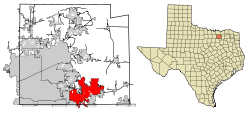Wylie, Texas
USGenWeb >> TXGenWeb >> Dallas County >> Towns & Communities >> Wylie, Texas
 |
|
| Latitude |
33°1′7″N 33.0151201 330054N |
| Longitude |
96°31′44″W -96.5388789 0963220W |
| Elevation feet/meters |
558/170 |
| Zip Code | 75098 |
| Founded | |
| GNIS FID | 1350621 |
| TXGenWeb Site | |
| Cemeteries | |
| Library | |
| Local Genealogy Society | |
| Wylie ISD | |
| Princeton ISD | |
| Rockwall ISD | |
| Garland ISD | |
| Wikipedia | |
| wylietexas.gov | |
|
|||||||||||||||||||||||||||||||||||||||||||||
Originally called Nickelville, reportedly after the name of the first store, it was organized in the early 1870s. The Gulf, Colorado and Santa Fe Railway laid tracks a half mile north of the original townsite in 1886. The businesses of Nickelville moved to take advantage of the railroad within the following year, and the City of Wylie was incorporated in 1887 along the right-of-way. It was named for Lt. Colonel William D. Wylie, a right-of-way agent for the railroad and Civil War veteran.
That same year, Wylie had given itself its name, established a post office branch, and incorporated, choosing an alderman form of government. Two years later, the St. Louis Southwestern Railway reached the town. The two railroads and the rich agricultural region of the Blackland Prairies contributed to the town's growth. In 1890, Wylie had a population of 400 and the first one-room school house was built. By 1900, it had grown to 773. In the next decade, the population tripled. Before 1920, the community had over 35 businesses, including two banks, a school, and a weekly newspaper.
.... Read More Wikipedia ....
David Minor
Wylie is on State Highway 78 sixteen miles south of McKinney in south central Collin County. It was organized in the early 1870s and originally called Nickelville, reportedly after the name of the first store. In 1886 the Gulf, Colorado and Santa Fe Railway laid tracks a half mile north of the original townsite. Within a year the businesses of Nickelville had moved to take advantage of the railroad and had named their new location Wylie, in honor of W. D. Wylie, a right-of-way agent for the railroad. That same year Wylie received a post office branch and incorporated, choosing an alderman form of government. Two years later the St. Louis Southwestern Railway reached the town. The two railroads and the rich agricultural region of the Blackland Prairies contributed to the town's growth. Wylie had a population of 400 in 1890 and 773 in 1900. Before 1920 the community had over thirty-five businesses, including two banks, a school, and a weekly newspaper. Unlike many rural Texas communities, Wylie grew during the Great Depression years, reaching 914 residents by 1940. In part this was a result of increased dairy farming to meet the demands of nearby Dallas. Following World War II the population continued to increase. The construction of Lake Lavon five miles north of town and the selection of Wylie to house the offices of the North Texas Municipal Water District, designed to provide water for towns in four counties, pushed the population to 1,804 in 1960. In the next twenty years the population more than doubled as a result of the growth of the Dallas urban area. In 1980 there were 3,152 residents and ninety businesses in Wylie. In 1990 the population was 8,716, and Wylie had spread into Rockwall and Dallas counties. By 2000 the population reached 15,132.
Bibliography: J. Lee and Lillian J. Stambaugh, A History of Collin County (Austin: Texas State Historical Association, 1958).
Handbook of Texas Online, David Minor, “Wylie, TX (Collin County)”
Nickelville is a ghost town in Collin County.
It was reportedly named after the name of the first store, and was organized in the early 1870s. The Gulf, Colorado and Santa Fe Railway laid tracks a half mile north of the original townsite in 1886. The businesses of Nickelville moved to take advantage of the railroad within the following year. The site to where they moved became known as Wylie.




